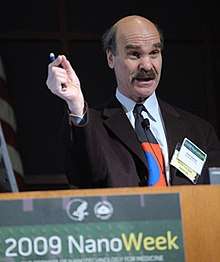Mark Ratner
Mark A. Ratner (born December 8, 1942) is an American chemist and the Lawrence B. Dumas Distinguished University Professor of Chemistry and Professor of Materials Science and Engineering at Northwestern University. He describes himself as a theoretical materials chemist and focuses on the theory of fundamental chemical processes related to nanoscale applications. Ratner also serves on the Governing Board for the Bulletin of the Atomic Scientists. [1]
Mark A. Ratner | |
|---|---|
 Mark A. Ratner in 2009. | |
| Born | December 8, 1942 |
| Nationality | American |
| Known for | unimolecular rectifier |
| Awards | Irving Langmuir Award (2004) Willard Gibbs Award (2012) Peter Debye Award (2016) |
| Scientific career | |
| Fields | molecular electronics |
| Institutions | Northwestern University |
| Doctoral advisor | G. Ludwig Hofacker, Jan Linderberg |
Education
Ratner graduated from Harvard University in 1964 with an undergraduate degree in chemistry. He obtained his Ph.D. in chemistry from Northwestern University working with G. Ludwig Hofacker, did postdoctoral work in Aarhus and Munich with Jan Linderberg.
Chemistry academic career
Ratner taught chemistry at New York University from 1970 until 1974. In 1974, he and Arieh Aviram proposed the first unimolecular rectifier, thus becoming a pioneer in molecular electronics.[2] He later served as a visiting professor with the National Sciences Research Council at Odense University. He served as department chair at Northwestern University from 1988 until 1991 and as associate dean of the College of Arts and Sciences from 1980 until 1984.
Ratner's more current areas of research include electron transfer, self-assembly, nonlinear optical response in molecules, and theories of quantum dynamics.
Ratner is a member of the International Academy of Quantum Molecular Science. He was nominated to the National Academy of Sciences in 2002.[3] In 2004 he was awarded the Irving Langmuir Award.
In May 2009, Ratner delivered the 14th Annual John Stauffer Lectures at Stanford University. The lecture subjects were "Transport in Molecular Junctions" and "Nano and Energy" (energy generation storage in high-tech solar cells and high-tech batteries).[4]
Some of Ratner's collaborators at Northwestern University are George Schatz, Yuri Berlin and Michael R. Wasielewski.
Selected works
- Molecular Electronics II (Annals of the New York Academy of Sciences) (1998-07) ISBN 1-57331-156-1
- Same (ed. with Ari Aviram, Vladimiro Mujica) (2002–05) ISBN 1-57331-410-2
- Quantum Mechanics in Chemistry (with George C. Schatz) (2002-01-28) ISBN 0-486-42003-5
- Nanotechnology: A Gentle Introduction to the Next Big Idea (with Daniel Ratner) (2002-11-18) ISBN 0-13-101400-5
- Nanotechnology and Homeland Security: New Weapons for New Wars (with Daniel Ratner) (2003-10-24) ISBN 0-13-145307-6
- Introduction to Quantum Mechanics in Chemistry (with George C. Schatz) (2000-05-18) ISBN 0-13-895491-7
References
- "Governing Board". Bulletin of the Atomic Scientists. Retrieved 2016-03-30.
- Aviram, A and Ratner, M.A.; “Molecular Rectifier” Chemical Physics Letters 29: 277 (1974)
- Biography of Mark A. Ratner by Emma Hitt, National Academy of Sciences, May 5, 2004
- John Stauffer Lectures May 2009